Malia Obama, Girl Photographer
Mary Celeste Kearney / University of Texas – Austin
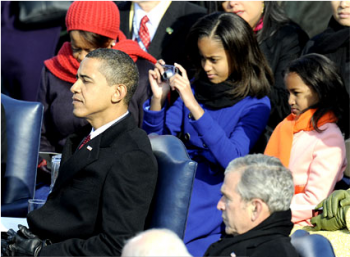
In addition to the comical fur-lined hat worn by former President George H. Bush, one of the more notable images during President Barack Obama’s swearing-in ceremony was that of his oldest daughter, Malia, snapping photographs of the occasion. Apparently, I wasn’t alone in noticing the young Ms. Obama’s photographic practices. At least one television network and five U.S. periodicals, including People, Wired, The Washington Post, and The New York Times, have run stories about the girl snapshotter after numerous photojournalists captured her in their lenses, turning this young spectator into the latest spectacle.
But Malia’s photography and media attention to it were not restricted to the swearing-in ceremony. On January 17, the 10-year-old was photographed taking pictures in Philadelphia before she boarded a train to Washington, DC with her family and that of Vice President-elect Biden.
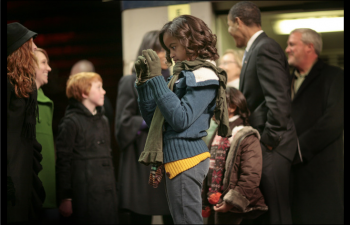
The following day, Malia was photographed snapping away at the Lincoln Memorial Inauguration Concert.

And the night before Inauguration, she was photographed with her camera in hand at the Kids’ Inaugural: We are the Future Concert.
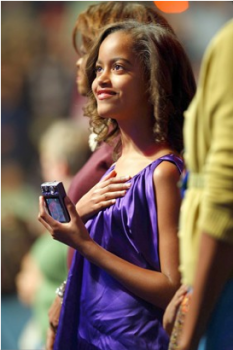
What is the significance of Malia Obama’s photographic practices, and why have they garnered so much public attention in the past few weeks? What fascinates us about this particular photographer? Are we simply excited by the possibility that we might see pix taken by a First Daughter on Flickr or Facebook? Or is something else piquing our curiosity? In order to answer these questions, we need to consider the history of girls’ photography, the role of media technology in girls’ lives today, and the racial landscape of American girlhood and girls’ culture.
After Kodak’s introduction of its small, portable Brownie camera in 1900, amateur photography became a common pastime for American youth. Boys had long been encouraged to tinker with such mechanical gadgets so as to prepare for future jobs and affirm their masculinity. Yet girls were not excluded from Kodak’s appeal and became quick adopters of this new consumer technology. Indeed, because early amateur cameras were relatively cheap (the Brownie retailed for $1.00) and did not require much skill to operate, photography swiftly became one of the primary means by which girls of the early twentieth century documented their lives and expressed themselves creatively, thus challenging the primacy of diarywriting, which requires elementary literacy of its practitioners. By the 1920s, photography had become such a hit with female youth that Kodak began manufacturing Girl Scout cameras, the first media technology created specifically for girls.1
As apparatuses that confer considerable agency on users while also encouraging their engagement with the outdoors, cameras offered additional bonuses to female youth of this period, which might explain photography’s quick ascendance in early twentieth-century girls’ culture. Like schooling and sports, photography enlivened a sense of mastery, control, and autonomy in its young female practitioners. In turn, it legitimized their participation in public life, thereby complicating the sex-segregated roles, practices, and spaces associated with Victorian society, which in turn helped to shift gender norms in a progressive direction.
From Kodak’s Brownie to today’s EasyShare (Malia’s current model of choice), photography continues to be a primary pastime for many female youth the world over. Indeed, judging from the number of girls who own cameras and camera-enhanced cell phones, it seems the dominant demographic group to occupy the role of photographer today is comprised of young females between the ages of 10 and 25. With toy manufacturers now creating pink and purple point-and-shoots for little girls, such as Mattel’s Barbie Smile with Me Camera, that age range is likely to skew even younger in the next few years, thus expanding the number of contemporary girl snapshotters.
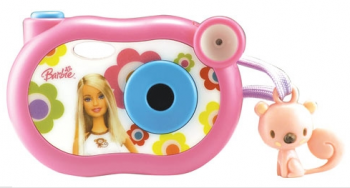
If girls’ blogs and MySpace pages are any indication, today’s female youth take photos of seemingly every person, object, and occasion in their lives, and no wonder: With no film cartridges to load, lenses to adjust, or processing to wait and pay for, digital cameras and cell phones have made photography super easy and efficient. Moreover, with the help of software packages, like Photoshop, female youth who are invested in photographic quality can manipulate their images without ever stepping foot in a dark room. But perhaps the most notable change in girls’ photo culture is related to distribution, not production. Girls’ snapshots, once carefully preserved in photo albums, can now be swiftly uploaded and circulated online, available for millions of viewers to see.
But contemporary girls’ photo culture is not just about taking and sharing images. Available in numerous colors and with a variety of accessories, today’s cameras are used by many female youth in much the same way as their cell phones—technologized consumer products that complete the public image of the postmodern “can-do” girl.2
If, as already suggested, Malia Obama is but one of the millions of young female photographers currently in our midst, then why all the excitement when she’s seen using a camera? Yes, she’s also a First Daughter, so anything she does, even the most typical of “girly” activities, is bound to garner public attention. (Remember images of Amy Carter walking a gauntlet of photojournalists on her way to school?)
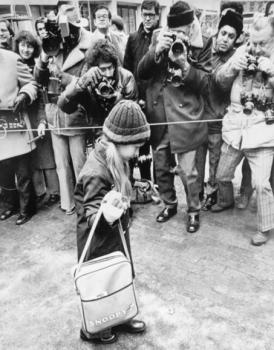
Yet the lure of Malia the Photographer does not just result from her relationship with the President of the United States of America, and thus her ability to capture images of one of our most public and powerful figures in his most private and perhaps vulnerable moments. Certainly, those factors pique our interest about this girl photographer. Nonetheless, I believe the primary reason Malia’s photographic practices have garnered so much attention is their juxtaposition with a young, female African American body. Most individuals in the U.S. are simply not used to seeing a black girl in a position of such agency. Stereotyped as crack whores and teen moms on welfare, black girls are more commonly constructed in the media as victims than heroes, “at-risk” rather than “can-do.”3 Thus, it seems Malia is attracting attention not just because she’s a girl who takes pictures or because she is a First Daughter who takes pictures, but because she’s a black First Daughter who takes pictures.
While most Americans have grown used to the concept of “girl power” and the idea of female youth interacting with cameras, PCs, and musical instruments, African American girls have not regularly been in our cultural limelight since the girl groups helped to revive Tin Pan Alley in the early 1960s. Despite some notable exceptions in sports and music, the vast majority of female youth who have received attention for their cultural agency has been white. This is not to say that girls of color have been absent from the field of cultural production. Plenty of African as well as Asian, Latin, and Arab American female youth have been engaged in media-making practices in the past few decades. Indeed, hip-hop culture would not have developed as it did if not for the Latina and African American girl DJs, MCs, break dancers, and graffiti artists who helped to create that scene in the 1970s.4 Yet, these are not the girl performers and artists that have attracted and held media attention. Given the overwhelming whiteness of contemporary American girls’ media culture—from dolls to magazines to musicians to fictional characters—is it any wonder that the girl performer most noted for her interactions with our black First Daughters is Miley Cyrus?
Malia Obama’s snapshotting has captured the public’s attention and thus encouraged a barrage of photographs of her in response. In addition to acknowledging contemporary girls’ technological agency, one of the most significant consequences of these images is that our whitewashed notions of girls, girlhood, and girls’ culture are beginning to disintegrate. With numerous cameras ready to capture her every move over the next four years, Malia is helping to alter the dominant image of American girlhood through her place in front of as well as behind the lens. Let’s hope she asks for an SLR for her birthday in addition to those Jonas Brothers’ concert tickets.
Image Credits:Images
1. Malia the Photographer at President Obama’s swearing-in ceremony
2. Malia in Philadelphia before the President-elect’s train leaves for Washington, DC
3. Malia and Sasha at the Lincoln Memorial Inauguration Concert
4. Malia at the Kids’ Inaugural: We are the Future Concert
5. Mattel’s Barbie Smile with Me Camera
6. Amy Carter on her way to school
Please feel free to comment.
- Mary Degenhardt and Judith Kirsch, Girl Scout Collectors’ Guide: A History of Uniforms, Insignias, Publications, and Keepsakes (Lubbock: Texas Tech University Press, 2005). [↩]
- Leslie Regan Shade, “Feminizing the Mobile: Gender Scripting of Mobiles in North America,” Continuum: Journal of Media & Cultural Studies 21.2 (June 2007) 179-189. [↩]
- Anita Harris, “The ‘Can-Do’ Girl versus the ‘At-Risk’ Girl,” Future Girl: Young Women in the Twenty-First Century (New York: Routledge, 2004) 13-36. [↩]
- Nancy Guevara, “Women Writin’ Rappin’ Breakin’,” The Year Left 2: An American Socialist Yearbook, eds. Mike Davis, Manning Marable, Fred Pfeil, and Michael Sprinker (Stonybrook: Verso: 1987) 160-175. [↩]
Mary- thanks for the column. I think photography is an underrated tool for media production and its uses among girls especially important now that there are new ways to use the photos taken. I will be curious to see how Malia’s journey with photography plays out both with her personal use of the camera (will she make a career out of taking pictures or continue to use photography as a way of remembering the events of her childhood) and if the media continues to take pictures of a girl taking pictures (is it really about the camera or just some way to bring attention to one of the First Daughters?).
Mary – interesting article and historical contextualization. I’m curious how Malia as photographer at her father’s inauguration fits into larger discourses of people feeling the need to document every moment of their lives as a way to “prove they were there”, as Sarah Perez discusses here. Certainly Malia knew she could have access to all the hundreds of photos being taken that day, yet she still chose to take her own photos with her own camera. As you note, I think this is an important demonstration of her exercising agency as a media producer and not merely a media consumer or object of interest (she is behind the camera not just in front of it).
Mary, Great article! I actually have one of those Girlscout cameras made by Kodak. Got it on Ebay. And I agree that Maila needs an SLR. I, too, was fixated on the images of Malia taking images! Whatever dis-empowerment she faces as the subject of thousands of photographers lenses will be flipped on its head as she takes pix of the picture-takers. A brilliant way to deal with being the specimen under the microscope! My first thought when I saw her snapping was “Malia needs to do a book!” The world from her eyes would be amazing.
I found this article very inspirational because of its message underlying the racial prejudice or stereotypes towards African American girls shown through media and how change is coming way as a result of Malia snapping shots through her camera. This message came across to me as the most touching and meaningful one because it reflects the long fight in breaking down racial stereotypes or prejudice in the face of the general American public and thus shows how America is becoming more liberal. This message is amazing and should be reached out to many in the public. It is such an significant underlying point to the U.S as well as to the world because it portrays a real side of African American girls that is not shown typically through media, based on historical events as well the general stereotypical occurences of these girls. I’m glad that that through this there is a different light shown now in how African American girls are portrayed or represented and I hope for later related messages are found and reach out to the American public.
This article caught my attention because I never really thought much of the fact that Malia Obama had a camera during the Inauguration Ceremony or any of the concerts and events surrounding that week. Technology has become such a huge part of our lives today that it’s very common to see people, even women and girls taking pictures with their cell phones or digital cameras. However I didn’t realize was the fact that seeing Malia taking pictures was an even bigger deal because of the fact that she is African American. We were all so caught up with swearing in our first Black President that we didn’t really pay much attention to the fact that by being Black and the First Daughter, Malia could be getting just as much attention too. This made me realize that even though African Americans may have been freed of slavery many years ago, they still struggle in their own way, and slowly it has been paying off and we are seeing barriers being broken. Rising up and moving away from our prejudices. Photography has really come a long way through advances in technology and it has really helped to shape our world and society today. It has become an easy and more interactive way for us to capture precious moments; therefore it should be embraced by all, regardless of race, color, gender, or age.
I was really excited when I saw this article because, after the inauguration, CNN posted this entire photo gallery called “Malia and Sasha’s Inauguration Adventure” which featured many photos of Malia clicking away and I couldn’t really understand why. I really enjoyed the historical context you provided on this bizarre issue and I am still wondering why Malia’s camera is such a prominent subject. Initially I felt like it was an odd attempt to make Malia seem like the average citizen, as opposed to the intimidating “first daughter” at the inauguration who is accustomed to special treatment and these grand events. By taking pictures, her position shifted to more of a spectator- one who is equally excited by the magnitude of the occasion- and made her all the more relatable to. So is this camera coverage an effort to make the Obama’s (via Malia) seem like the average Americans and therefore more understandable, or just a means of satisfying our sick craving for celebrity and news coverage? But really, I wouldn’t be surprised if it was just a deliberate product placement for the Kodak Easy Share…
At first when reading this article I did not understand what the hype was about. To me, it is just a simple girl trying to capture the moment of her father becoming the President of the United States. However, reading more in depth I began to identify the way race and gender played a key role to this story.
In this article, the key subject is about how Michelle Obama always happens to have a camera every time she is photographed. However, I don’t believe this is a coincidence. Photographers are trying to display a bigger meaning then just a first daughter taking a picture. To recap, the camera was developed in 1900s, which was during the segregation war: white vs. colored, and female vs. male. As discussed in the article, “like schooling and sports, photography enlivened a sense of mastery […] in its young female practitioners”. When women would use a camera during this time it helped women develop a status that was somewhat equal to men. Therefore, these pictures of Michelle Obama not only display an African American girl who is taking pictures but also, in a greater perspective the equality of young women in today’s time. And not just any women, but African American women. As mentioned in the article, people are not use to seeing women in a position of “such high agency,” let alone an African American woman.
Another key argument is that they are trying to display the new young African American women. In today’s society, young African American women are seen as “soon to be mothers” or “young failures.” But with this picture, they are representing race and gender in a new type of way. They are showing that a “can-do” girl does not only have to be white, but can now also be black. With this in mind, the photographer displays a young girl who in a greater perspective illustrates the new young African American girl.
Mary,
This article’s title caught my attention, so i decided to follow the link on the homepage and read on. The idea of a first daughter being a photographer was an intriguing one to me–as you stated she has the ability to capture the president in his most intimate and perhaps vulnerable states. For a young mind, a camera holds great prospects in developing perspective as well as creative interpretation of life’s many situations. For Malia, the situations that arise in her life will greatly very from those i’ve experienced in–my parent after all is not the president of the most influential nation on earth. Also, as a girl living in the digital age where importing such images is only a usb port and a few mouse clicks away the images she captures can potentially be very interesting. I am curious to see what happens as she develops as a photographer, perhaps we will see the first, first daughter photo blog, possibly reveling an un-staged, unadulterated perspective of the first family.
Malia Obama was relatively unknown to most of Americans until the past year or so. Whenever media has focused on the daughter of the new President of America, they are focused on her interesting will to photograph certain events. Regardless of the media illustrates Malia, can we understand that this is the daughter of the president and she may just want to document this extremely important and life-shaping part of her life? Technology and youth has become part of Obama’s platform that allowed him to connect so many voters together. Similar to Malia’s camera, children are harnessing technology and able to take digital camera, video, and upload them onto a computer to share with their families and friends. Microsoft has been running an advertisement with a young girl (4 yrs old) that takes several pictures, uploads them, enhances their quality, then sends them via email to her family members. Being able to document a child’s or teenager’s life has become easier with the technologic advances and social websites like MySpace and Facebook are making it not only linked but a priority.
Pingback: Girls in the White House: Malia Obama and Courtenay Valenti « Act Your Age